Seventeen of the 217 passengers who arrived on long-haul at Taiwan Taoyuan International Airport yesterday morning tested positive for COVID-19, the Central Epidemic Command Center (CECC) said, adding that the positivity rate was higher than expected.
Yesterday was the first day that the government enforced stricter health guidelines for the testing of passengers arriving on long-haul flights. They must undergo a polymerase chain reaction test immediately after arriving at the nation’s international airports. Those who test positive are sent directly to hospitals to avoid spreading the virus to people working in and around the airports and at quarantine hotels.
Victor Wang (王必勝), deputy head of the CECC’s medical response division and the center’s on-site commander at the Taoyuan airport, said that the 217 passengers arrived on five flights: one from Seattle, three from Los Angeles and one from Sydney.
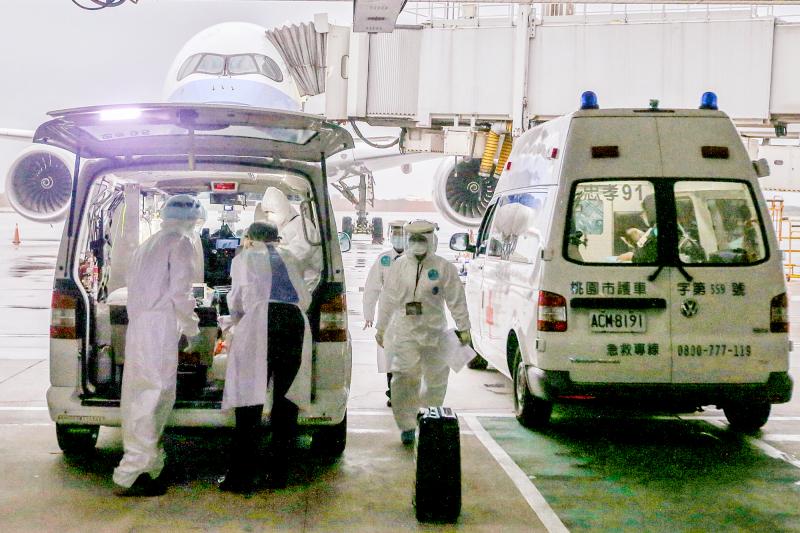
Photo: CNA
Of the 17 infected passengers, four arrived from Sydney and 13 arrived on the three flights from Los Angeles, while the passengers from Seattle all tested negative, he said.
The total COVID-19 positivity rate among all passengers was 6.7 percent, which was “higher than we had imagined,” Wang said.
The center’s on-site personnel made adjustments to speed up tests after it took them about two hours to screen samples gathered from passengers on the first flight that arrived in the morning, Wang said.
“We experienced delays when screening the samples gathered from the passengers on the first flight, but we made a quick adjustment for flights arriving afterward,” Wang said.
“We want passengers who test negative to leave the boarding gates in an hour and proceed to immigration and customs. For those who test positive, we would try to reduce their waiting time, although it is difficult to control the time needed to process their samples,” he said.
As only 20 machines were available to process samples yesterday, Wang said the center would try to add new machines in the next few days to reduce waiting time for passengers.
About 4,200 passengers are expected to arrive daily from Thursday to Saturday for the Lunar New Year holiday, which starts on Jan. 31, Wang said, adding that the government would ensure that there are sufficient medical personnel at the Taoyuan airport to meet demand.
“We are also expecting more positive cases in the next few days, and hospitals in Taoyuan and nearby cities and counties are expected to accept COVID-19 patients,” he said.
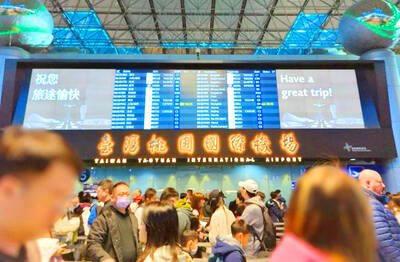
Foreign travelers entering Taiwan on a short layover via Taiwan Taoyuan International Airport are receiving NT$600 gift vouchers from yesterday, the Tourism Administration said, adding that it hopes the incentive would boost tourism consumption at the airport. The program, which allows travelers holding non-Taiwan passports who enter the country during a layover of up to 24 hours to claim a voucher, aims to promote attractions at the airport, the agency said in a statement on Friday. To participate, travelers must sign up on the campaign Web site, the agency said. They can then present their passport and boarding pass for their connecting international
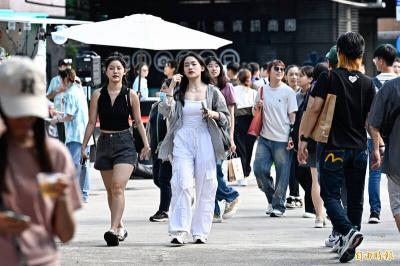
Temperatures in northern Taiwan are forecast to reach as high as 30°C today, as an ongoing northeasterly seasonal wind system weakens, the Central Weather Administration (CWA) said. CWA forecaster Tseng Chao-cheng (曾昭誠) said yesterday that with the seasonal wind system weakening, warmer easterly winds would boost the temperature today. Daytime temperatures in northern Taiwan and Yilan County are expected to range from 28°C to 30°C today, up about 3°C from yesterday, Tseng said. According to the CWA, temperature highs in central and southern Taiwan could stay stable. However, the weather is expected to turn cooler starting tonight as the northeasterly wind system strengthens again
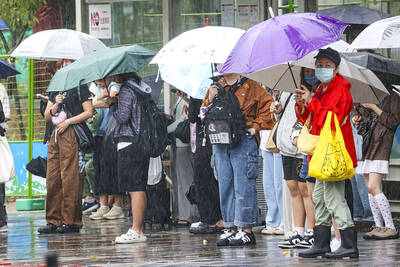
COOLING OFF: Temperatures are expected to fall to lows of about 20°C on Sunday and possibly 18°C to 19°C next week, following a wave of northeasterly winds on Friday The Central Weather Administration (CWA) on Sunday forecast more rain and cooler temperatures for northern Taiwan this week, with the mercury dropping to lows of 18°C, as another wave of northeasterly winds sweeps across the country. The current northeasterly winds would continue to affect Taiwan through today, with precipitation peaking today, bringing increased rainfall to windward areas, CWA forecaster Liu Pei-teng (劉沛滕) said. The weather system would weaken slightly tomorrow before another, stronger wave arrives on Friday, lasting into next week, Liu said. From yesterday to today, northern Taiwan can expect cool, wet weather, with lows of 22°C to 23°C in most areas,
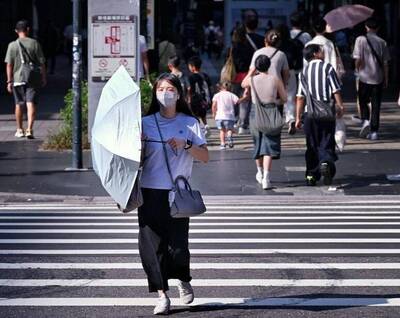
Taiwan sweltered through its hottest October on record, the Central Weather Administration (CWA) said yesterday, the latest in a string of global temperature records. The main island endured its highest average temperature since 1950, CWA forecaster Liu Pei-teng said. Temperatures the world over have soared in recent years as human-induced climate change contributes to ever more erratic weather patterns. Taiwan’s average temperature was 27.381°C as of Thursday, Liu said. Liu said the average could slip 0.1°C by the end of yesterday, but it would still be higher than the previous record of 27.009°C in 2016. "The temperature only started lowering around Oct. 18 or 19